An important preface from the author, an armchair architect at best and a golfer who enjoyed all the courses mentioned below quite a bit: Don’t get mad when reading this piece. Have fun, and comment liberally with your own hole edits.
It was a relatively short golf year for me, so I briefly considered letting the third-annual rendition of this feature slide by the wayside. But last year’s edition also got a brief mention on GolfClubAtlas, which lends an air of legitimacy to my hobby (if not money), and so I decided I must go on.
The gist: You’ve likely read a list, by someone much wealthier and/or better connected than you (power to them), listing the best golf courses that they played during the past year. These create intense levels of envy among the less wealthy / well-connected. I’m starting to get over that part, but I’m still bugged by how unwilling the average adventurer is to say something even vaguely critical about acclaimed clubs, unless that complaint has already been beaten into a clichéd pulp by the masses before them (trees at Augusta! You don’t say!).
I’m both realistic and, admittedly, cynical. I don’t believe the perfect golf course exists. In an attempt to project sincerely, and keep those GolfClubAtlas guys interested in my minimal adventures, I often don’t focus on the great stuff at the great courses I played. Hence my annual “best of” format: Rather than simply slobbering to you about about Ballyneal’s brilliance, I choose my least favorite hole and offer suggestions for improvement.
That would be too easy, however, so there’s a twist: I redesign each hole from the mindset of a different golf course architect…specifically a golf course architect who designed a different course on my year-end list, whose own hole will be dissected in the style of one of his cohorts later on. Confused? You’ll figure it out. Let’s start with a tough one, and hopefully learn something about these architects and some otherwise pretty great courses.
Let’s find out what might happen if LANGFORD AND MOREAU redesigned NO. 9 at BALLYNEAL GOLF CLUB. (If you ended up enjoying it, you can also check out the 2021 and 2022 versions of this exercise)
What would happen if LANGFORD AND MOREAU redesigned NO. 9 at BALLYNEAL GOLF CLUB?
There’s a cost to putting a clubhouse on the highest point of the property, especially if your property has, you know, actual elevation change. Eventually, the routing that goes down must come back up and, while players have no problem launching down a pronounced hillside, both hitting and walking back up evokes less joy.
I’m not going to fault Tom Doak for placing No. 9 here. I could point out that he’s never been shy about skirting return-to-the-clubhouse routings before, but that would undercut the utilitarian argument that something needed to attach the green of No. 8, a fantastic hole, to the tee at No. 10, a fantastic hole. And that means trudging back up the hill toward the lower side of the clubhouse campus, which sits, to be fair, significantly lower than the upper side of that plot. At just 362 yards from the back tees, the slope’s not unbearable at No. 9. You can get there. The straight nature of the hole, however, makes it more likely that your significantly-longer playing partner will have a better look at the green, due to your shot not getting up the hill to the fairway pinch point. And Doak, again if-I’m-being-fair, accommodates with some punchbowl-type features around the front of this green for those facing a longer approach.
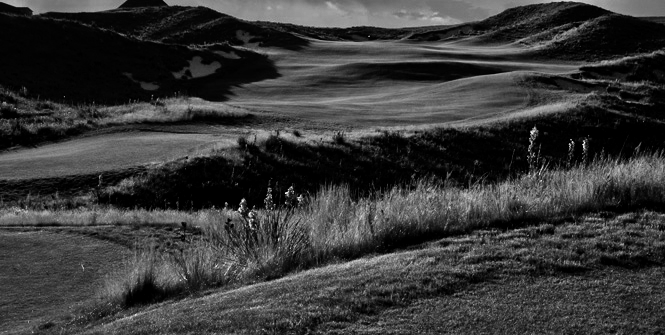 This is a good-enough hole. It’s also the worst hole at Ballyneal. (Photo Cred: Ballyneal Golf & Hunt Club)
This is a good-enough hole. It’s also the worst hole at Ballyneal. (Photo Cred: Ballyneal Golf & Hunt Club)
Man, look: This really isn’t too bad of a hole. Ballyneal appears every Top 100 list for a reason. But after the popping personalities at all-world Nos. 7 and 8, and the ghost of awesome yet-to-come at No. 10, I really want some more zazz at No. 9. Both a recent round played at one of their classics and a well-publicized renovation project make me think Langford and Moreau are the ones to do it. Let’s start with the tee.
Someone, probably Brian Schneider, is going to tell me exactly why Doak couldn’t put a teebox a little northeast of the No. 8 green, but for right now I’m running with it. I also know that, for the joys of minimalism on display at Ballyneal, No. 9 may be the least minimalist hole on the course, and that Doak was forced to chop down some chop hills to create even the current corridor at No. 9. So I reckon Langford and Moreau, hardly minimalists, can smudge down the tip of the ridge that’s running along the west of the No. 8 green, and create a tee box behind where Mulligan No. 7’s green sits.
I aim to create a dogleg left; ultimately, you’ll still want your ball to end up in the same position as you would today. Now you’ve got two challenges to get there: First, another ridge ends at the current bunkers on the left, which will impede your view…you’ll need to hit a draw for the daring shot, or just hit straight out for the safer one to the right side of the fairway. Second, a new bunker constructed by our friends Langford and Moreau compounds your interest in playing it safe.
The inspiration came from an aerial photo posted by Tyler Rae, prior to the groundbreaking at Iowa’s Wakonda Country Club, showing a Hawkeye hoss of a bunker guarding the inside of the dogleg at No. 7. I don’t propose one running the length of the front fairway, but something of similar intimidation level sitting inside the dogleg would make a better player think. At this point they’re hitting a 250-yard tee shot to position A (about the same as today), and getting over the new Wakonda bunker only requires maybe 165 through the air. Its placement between rolling formations (the fairway rises steeply to its right) creates some visual deception, while blustery western winds invoke some nerves, and perhaps the player decides that a longer, more murky second shot outweighs risk during the tee shot.
A second shot doesn’t sound so bad, either, because Langford and Moreau have converted No. 9’s dance floor into an auditorium. Those who measure success in simple GIRs will adore the Langfordized green…although those who appreciate scoring points during matchplay may see through the new gentility. There are many putting surfaces at Ballyneal that immediately make one regret a GIR — depending where you land, a chip and a putt now seems eminently more doable than a two-putt from the wrong position. This thought only amplifies at places like Culver Academies, where missing GIR seems shameful based on the clubhouse-sized greens available upon approach. But are you more likely to make birdie, or even par, by navigating the distance between mammoth mounds in two putts, or chipping on from aways and setting up, theoretically, one make-able putt?
Because this exercise revolves around me having fun, versus strict sensibility, Langford blows up Ballyneal No. 9’s green to Culver scale. Even Google seems to show an outline of the massive dimensions found in Indiana. The front humps that once redirected incoming shots? Those are now in the green. It’s absurd, yes, but it’s not far removed from the Langford and Moreau reality. This enormous green invites some insanity as some players may try blasting a tee shot past the fairway pinch point and immediately onto the putting surface (it will be 310 to the front of the green.
They may be left wondering, when they take a look at a 30-yard putt, whether such a decision was wise.
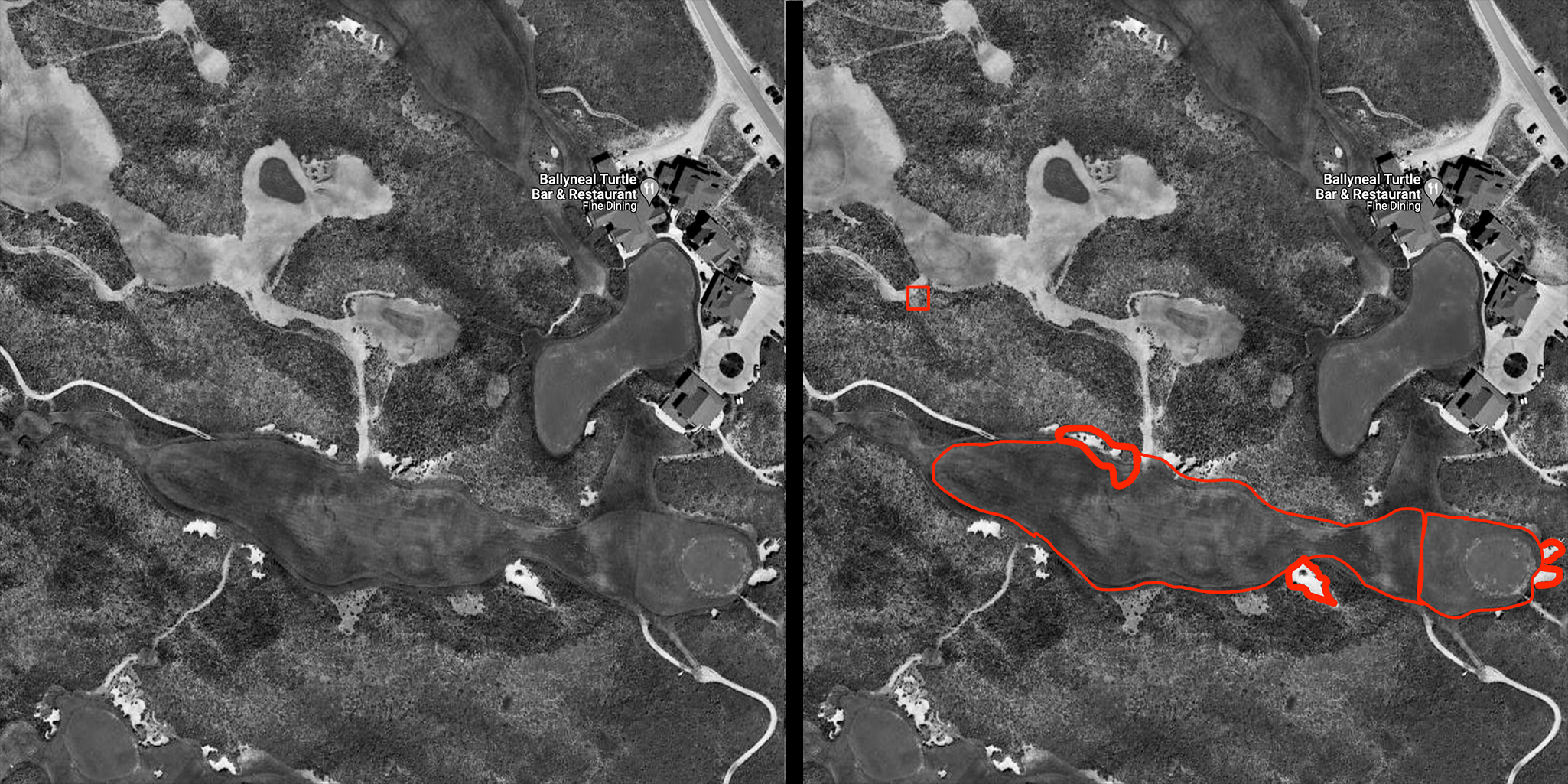 I screwed up a bit here…the tee box should be moved back a few yards…but the scale of the green? No, that’s idiocy I meant to do. (Photo Cred: BPBM Graphics Team)
I screwed up a bit here…the tee box should be moved back a few yards…but the scale of the green? No, that’s idiocy I meant to do. (Photo Cred: BPBM Graphics Team)
What would happen if TOM DOAK redesigned NO. 12 at CHERRY HILLS COUNTRY CLUB?
As modern appreciators for Golden Age architects, we frequently forget that the Golden Age architects themselves debated the merits of various course design concepts (and frequently contradicted themselves as well). If you were looking for a Golden Age dude on whom to base your justification for the penal era, William Flynn would be a good choice, and Cherry Hills Country Club would present some solid examples of concepts that modern snobs choose to overlook because Flynn did it (versus his pupil, Dick Wilson).
Several holes flaunt this most; No. 17, the first par five with an island green, and No. 18, featuring a tee shot that (MacRaynor snobs are going to complain quite a bit when I refer to this as a “Cape” tee shot) a Dye-style Cape tee shot long before Dye had the same idea. Even the tree at No. 4’s dogleg could merit moans had it come from another architect. The only one of these holes I have a significant problem with, however, is No. 12.
I realize I just inadvertently made a positive comparison between Nos. 18 at Cherry and TPC Sawgrass, but No. 12 evokes Sawgrass in a less pleasant way. Essentially a long carry over a man-made pond…and it’s the latter point that really gets to me. I don’t mind a forced-carry par three per se, but I’m really expecting the surroundings to justify it. Cypress Point-type stuff. Little Dry Creek complements the lower portion of the course so well during the round, both strategically and aesthetically. Flynn has dammed up the property’s other stream, “City Ditch,” to create a water hazard almost as ungainly as its title. I don’t want to assume regarding the awkward bail-out area to the left, but I’m willing to bet even Gloria Steinem embraces alpha male American culture too much to hit a ball over there while playing with a foursome.
 Go ahead. Hit to that lay up fairway thing on the left. We’re SURE your buddies won’t judge you. (Photo Cred: Cherry Hills Country Club)
Go ahead. Hit to that lay up fairway thing on the left. We’re SURE your buddies won’t judge you. (Photo Cred: Cherry Hills Country Club)
Tom Doak won’t fix the pond today, because restoring this to its original (read: pre-Flynn) state likely means flooding along a large swathe of property. Instead, let’s focus on the green, and another nearby Doak putting surface that I enjoy more. I couldn’t help but consider the similarities between No. 12 and CommonGround’s No. 6, which I had played the previous day.
The latter offers a bailout area right, allowing the more confident golfer to go full carry into the heart of the green, while those less enthusiastic for glory can come up short into a fairway apron. Both feature flatworm-shaped water hazards and both, coincidentally(?!?), play within one yard of the other from the back tee. Many may prefer the central ridge of Flynn’s Cherry Hills hole, but I liked Doak’s concept for its two levels, and especially the ability to use the slope up to the back level to backboard for front pins or, with a right-to-left shot, ride the ramp over to the most dangerous pin position at the front-left. He won’t replicate the putting surface inch-by-inch here, as this flatter portion of the property won’t let it look natural. That said, the green speeds at Cherry are much more aggressive than at their municipal cousin, and players who chicken out and hit long will face a nasty pitch when trying to get up-and-down from behind the green. To appease those who accuse us of catering to mid-handicappers, we’ll pull the “airbag” bunker at the front of CommonGround No. 6, which saves centerline shots that don’t quite make the putting surface, or the aforementioned back-of-green saves.
You did not come here, to a blog titled “Bethpage Black Metal,” to have Tom Doak simply swap out one green with another, however. Doak got the gears rolling earlier this year when he revealed a new addition to the soon-to-reopen High Pointe Golf Club near Traverse City: a par three featuring two greens. Play the shorter of the two, and you’ll be next to a tee box for the next hole, a par five. Play to the longer of the two greens, however, and now the tee box for the par five makes the hole more of a par 4.5. In short, a two-hole choose-your-own-adventure.
If you were wondering how we would fix that awkward bail-out fairway, now you know. I envision a green playing about 50 yards shorter than the original. The most exciting flags, of course, will sit alongside the pond on the flatter right-hand side of the green. Players can either attack it directly, try to land on the more mounded left half and allow the ball to trickle back down to the flag, or — because the green won’t encompass the entirety of the existing fairway portion — try running it up and working the slopes that way.
This doesn’t necessarily make an amazing hole out of No. 13, but the difference will be especially enjoyable for the bigger hitters. Those who played to the short green will play the hole at its “usual” distance, a not-too-challenging 425 from the tips. Play to the longer, “original” green location and you now have a 295-yard drive to the center of the green from the current forward tee. With Dry Creek sitting maybe 30 yards ahead of that, and a gnarly up-and-down from behind, could have been interesting for the U.S. Amateur this year.
Doak’s associate Eric Iverson got to design a new par three (No. 8) while Renaissance restored Cherry Hills, and now Doak has a proper original as well.
 All I can see when I look at this pond is a flatworm. Weird personal problem. Hopefully you’ll focus on the greens instead. (Photo Cred: BPBM Graphics Team)
All I can see when I look at this pond is a flatworm. Weird personal problem. Hopefully you’ll focus on the greens instead. (Photo Cred: BPBM Graphics Team)
What would happen if WILLIAM FLYNN redesigned NO. 14 at KIRTLAND COUNTRY CLUB?
Kirtland Country Club’s back nine often earns descriptions as among the best in the United States. Whether non-Ohioans say this is beyond me, as my feed tends to be cluttered up with fellow heart-of-it-all folk. Regardless, Kirtland’s place within the state’s top ten remains assured. The back opens with a dive, 125-feet plus, down from the higher part of the property, to the Chagrin River valley below. Numerous tee shots are taken over said river — some strategic and some simply scenic, but fun all around, even when the course begins its significant trudge back up the hill.
The exception, however, occurs at No. 14, where C.H. Alison chose to create a dogleg right that does its utmost to avoid the river, hugging the far side of the property on the other end of the floodplain.
I’ve got a few theories as to why. Most obviously, a tee shot back toward the river could potentially prove hazardous to players on No. 14, as it could bring them into range of those teeing off at No. 13, hitting downhill and across the river to what would end up being a parallel fairway. My second theory is that the hole I’m about to propose would play to about 360 yards, and Alison wanted a beefier mid-length on the back nine. (Editor’s Note: After writing this draft, I spoke briefly on the subject with Jim Nagle, who’s consulted with the club for quite a while. He noted his admiration for Alison’s routing ability, suggesting — coincidentally — that only Flynn rivaled him. Nagle’s guess for Alison’s routing was fear of Chagrin flooding, which continues to impact the back nine to this day. Needless to say, the solution presented below defies such logic but, again, we’re having fun here).
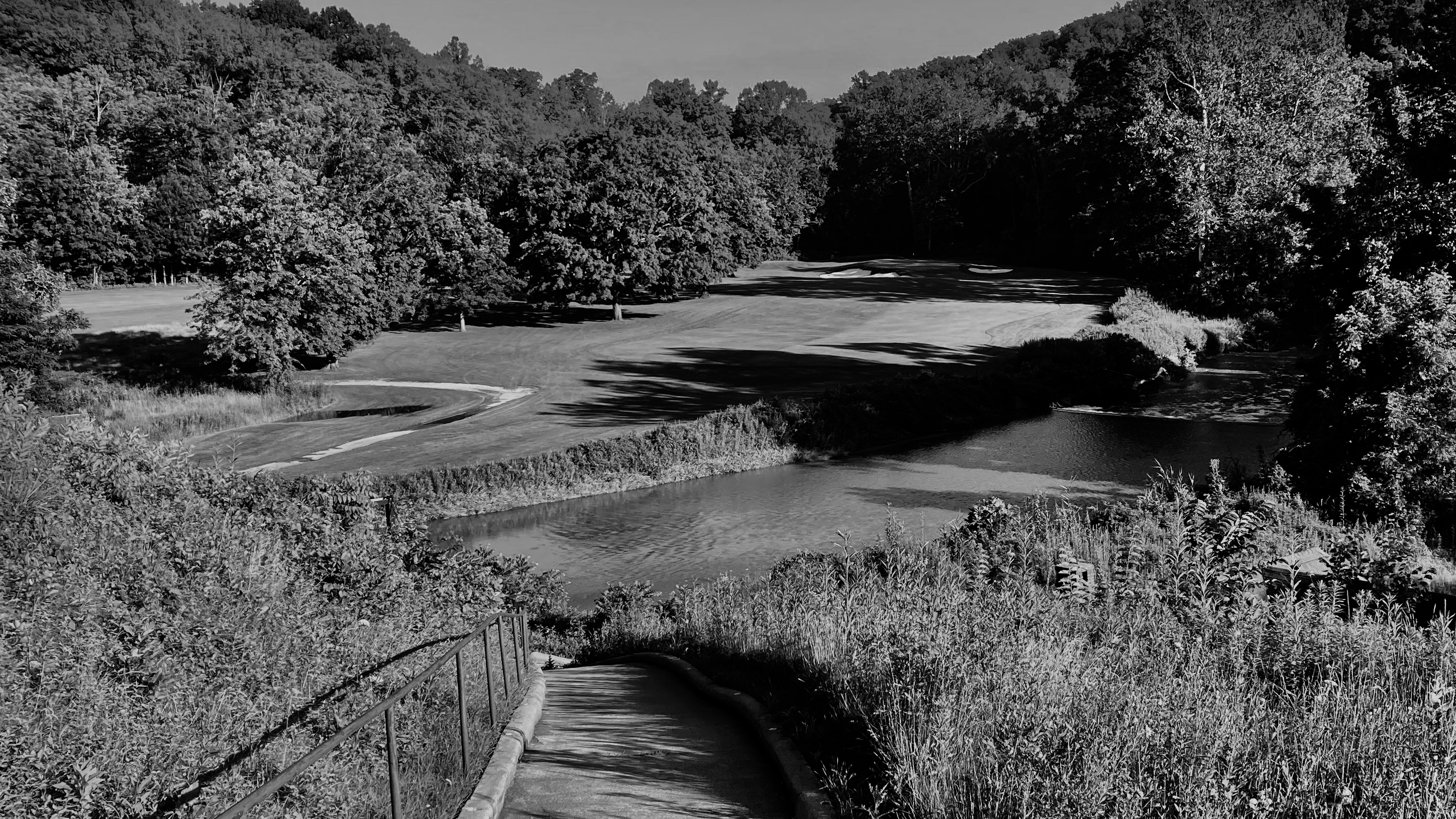 This is the sexier tee shot from the No. 13 tee…those trees are a safety buffer between the No. 14 fairway…but then again, they might suck up excess moisture from the Chagrin River as well. (Photo Cred: BPBM)
This is the sexier tee shot from the No. 13 tee…those trees are a safety buffer between the No. 14 fairway…but then again, they might suck up excess moisture from the Chagrin River as well. (Photo Cred: BPBM)
William Flynn, fortunately, has little concern for these issues. Or, at least, he’s got solutions to address both. Let’s discuss the second problem, the differentiation of back-to-back holes of similar length, first. It’s worth noting that Alison used zero fairway bunkers on No. 13, as the Chagrin guards the strategic right side of the fairway. Flynn immediately contrasts this approach by incorporating two defining fairway hazards.
The first will be the largest on the property, as well as the least interesting within this hole. This large expanse will line the front half of No. 13’s fairway, and continue to angle toward the No. 13 tee. For legal reasons, this deters those avoiding the river too eagerly and endangering players on No. 14’s fairway, but also the all-too-clever who realize this portion of No. 13’s fairway provides a nice line into No. 14’s green. It’s only fair that hugging the right side of this desert results in a better line, of course. The next two bunkers are where things get more exciting. And Flynn-y.
First, a bunker roughly the size of the current centerline at No. 14 provides a tight pinch at the dogleg. Those seeking Position A2 will attempt to thread the gap between the aforementioned giant bunker and this gatekeeper, about 275 yards from the back tee. The bigger hitters could go for position A1, which involves carrying the corner bunker and leaving as little as 60 yards to the green after the rollout. Bunker three, greenside right, discourages such thought.
Although No. 14 sits on a floodplain, the tee shot does travel ever the slightest uphill, which allows William “Nature Faker” Flynn to do some visual wonders. Spaced correctly, the two sand hazards along the right bleed together for those playing that way, leaving little indication as to what’s sand and what’s second cut for the final hundred yards of the hole. Those bombing from the tee will see the flag…but also a second sand barrage apart from the first. Even better, those laying up short of the corner bunker won’t have a simple 120-yard shot. They’ll have a 120 yard shot that looks like all carry. Come up short and land in the greenside bunker. Aim too far beyond and, as promised at the beginning of this entry, land in the river, which serves as a hazard along the left for this hole’s final hundred yards.
Flynn strung bunkers strategically to create intimidating approach views across his portfolio, notably at Shinnecock Hills (nos. 8 and 13). By doing so here, at No. 14, he makes it so that Kirtland’s back nine rests firmly in the national discussion, and not just the Ohioan one.
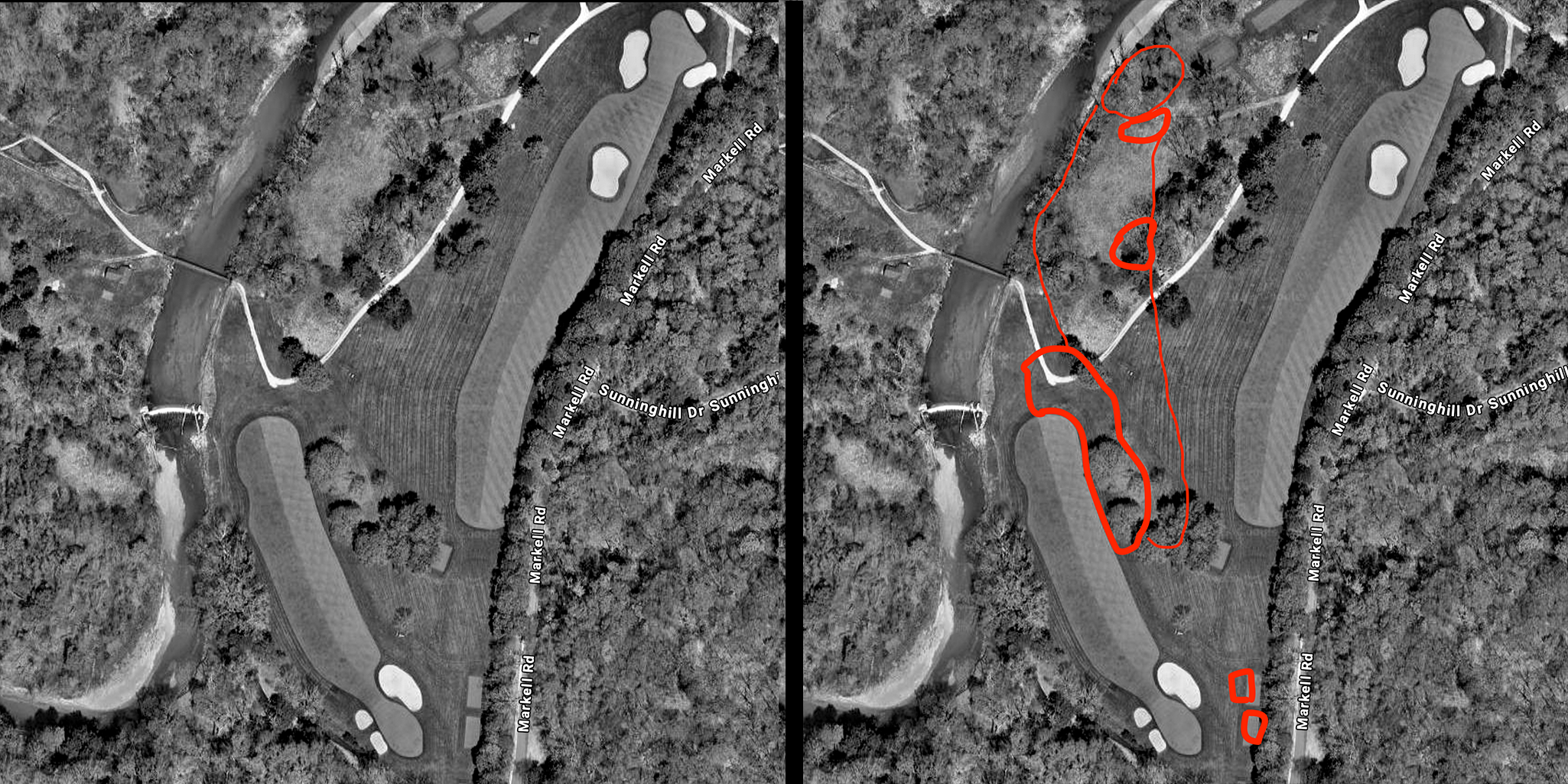 As reference frequently across this post, I’m more into sex appeal than logistics. (Photo Cred: BPBM Graphics Team)
As reference frequently across this post, I’m more into sex appeal than logistics. (Photo Cred: BPBM Graphics Team)
What would happen if C.H. ALISON redesigned NO. 5 at THE DUNES CLUB?
At least three out of my four loyal readers already learned a bit about my thoughts on The Dunes Club, particularly as it relates to each of the club’s par fours having the potential to be drivable. If you’ve read the post, you know that the drivable version of No. 5 is my least favorite, and even if you haven’t read that post, you now know that No. 5 is my least favorite hole at the club in general.
It’s been said before, and not just by me, but I’ll rehash: It just doesn’t feel much like the other eight holes here, and it seems especially out of place at a Mike Keiser property. Granted, he and architect Dick Nugent deserve a break here. Most golf courses require irrigation, and most club owners prefer that irrigation to come from retention ponds. When you’ve got a plot as small as Dunes does, you occasionally need to make do. In this case, that means a pond right in the middle of the property. Perhaps aiming to impact as few holes as possible, the vast bulk of this hazard comes into play during No. 5, specifically. About an 100-yard forced carry to the green, depending on where you strike it from. The putting surface, recently redesigned by Jim Urbina, doesn’t quite fix the vibe.
Alison did not necessarily deal with this issue all too much during his day, but he’s certainly dealt with tee shots over huge waste areas, with minor ponds to boot, namely at Hirono. If he could do it there, he could certainly do it here.
 Mike Keiser famously once required his golf properties be on the ocean. This…is close, I guess. (Photo Cred: BPBM)
Mike Keiser famously once required his golf properties be on the ocean. This…is close, I guess. (Photo Cred: BPBM)
He’ll start with the tee shot, which addresses one issue I have across Dunes, and not necessarily just at No. 5: The large waste areas are gorgeous, but generally enforce distance control, and not direction control…they make you consider picking up a smaller stick when they cross the fairway, but don’t necessarily provide risk/reward for playing to the proper location (granted, the proper line into the green rewards knowledgable players upon Dunes’s wide fairways). Taking a slight hint from No. 8 at Hirono then, we’re going to greatly expand the waste area here so that it climbs farther and farther up the fairway on the right, finally ending about 250 yards out, which will ultimately provide the best line in.
The rest of the “front’ fairway remains the same, including the waterline, allowing players two options from the tee. I describe the first, and best, above. Those who get past the extended right waste have about 50 yards until the water comes into play. From position A, the center of the green might be 150 yards, with the best angle in. Position B remains open down the left of the fairway, a tighter finger of fairway that extends a bit toward the water, offering more room for your driver and, accordingly, a shorter shot in (perhaps 120 yards), but at an angle that features water fronting the approach. Although the front of the waterline remains the same, Alison will opt to alter the shape of the pond to suit his needs. First, he’ll make the far right of the pond about 40 yards to carry, down from 90 yards today (in order to make up for the loss, he’ll widen the pond to the left, nearer to the No. 8 fairway, which will add little to no threat on the tee shot for that hole). This creates a significant landing area on the other side of the pond, for those who don’t feel comfortable attacking the green, which now spoons the water nicely along the left.
As it stands, we’ve got a hole that, from the front tees, plays to 280 yards, thus ensuring Alison’s new No. 5 continues the Dunes tradition that there be a drivable version for each par four (just something I noticed…I don’t know whether Keiser intended it so). Players can make a run at this green and miss far right, however, with little punishment. A Hirono-esque “Alison” bunker guarding the front-right edge takes this benefit away. Couple it with a putting surface designed to slope downward from back to front, and anyone hitting from behind the green’s entrance skates on thin ice. And that’s only during the Winter — hit that shot during the Summer and you’re likely wet.
Being an armchair GCA enthusiast, naturally my subconscious steered me toward making this a Redan green. The wiser portion of my brain, however, pointed out that although Alison had created several Redans in his time, both he and you wanted something less predictable here. Therefore we’ll finish this hole with another green that he more famously replicated on Long Island: the Gibraltar. This MacKenzie Mooriginal features right to left movement, but with more putting pockets and internal contours to keep the spirit of Urbina’s modern gem intact.
 I hate when a graphic is bad enough that I need to provide an explanation in the caption, but here we are. The green is the thing with the arrows in it. At the back is some of the natural waste area (similar to what’s there today) but that also bleeds into a proper bunker guarding the front-right of the green. Take note when playing in a PGA Championship. (Photo Cred: BPBM Graphics Team)
I hate when a graphic is bad enough that I need to provide an explanation in the caption, but here we are. The green is the thing with the arrows in it. At the back is some of the natural waste area (similar to what’s there today) but that also bleeds into a proper bunker guarding the front-right of the green. Take note when playing in a PGA Championship. (Photo Cred: BPBM Graphics Team)
What if JIM URBINA redesigned NO. 5 at CULVER ACADEMIES GOLF CLUB?
The loop at Culver Academies is the best nine-hole course I’ve thus far played, and that’s in no small part due to the club’s bookends, a pair of reachable par fives. Culver may benefit most for its enormous putting surfaces that, aside from simply awe the player with their scope, weaponize the GIR so that players who get there quicker may ultimately find themselves regretting it (go back to our description of Langford and Moreau’s redesign at Ballyneal to refresh yourself on what I’m talking about).
It’s therefore ironic that the worst hole at Culver is the par five that’s most reachable and, if I’m correct, features the second-largest putting surface in Indiana (trailing only the hole that follows it). Where does No. 5 go wrong, when Nos. 1 and 9 fly so true? For one, it’s far too reachable. Ironically, it’s not actually the shortest of the three, measuring 491 and therefore outstripping No. 9 by 10 yards. But that closing number has paranoia in spades, opening with a blind tee shot, followed by either a long, blind approach (for those who pulled driver regardless) or an ever longer, but more visually-welcoming approach (for those who laid back due to aforementioned blind tee shot).
No. 5 features just one fairway bunker, about 180 yards up the right side, when green-seekers know to hug inside of a dogleg-left. Playing from the back tees, a 250-yard drive leaves you something like 230, downhill, to a green only a smidge smaller than the Culver Summer Schools & Camps offices next door. Nothing wrong with a pat-on-the-back bird, but this handshake comes far too gentle for this deep into the round.
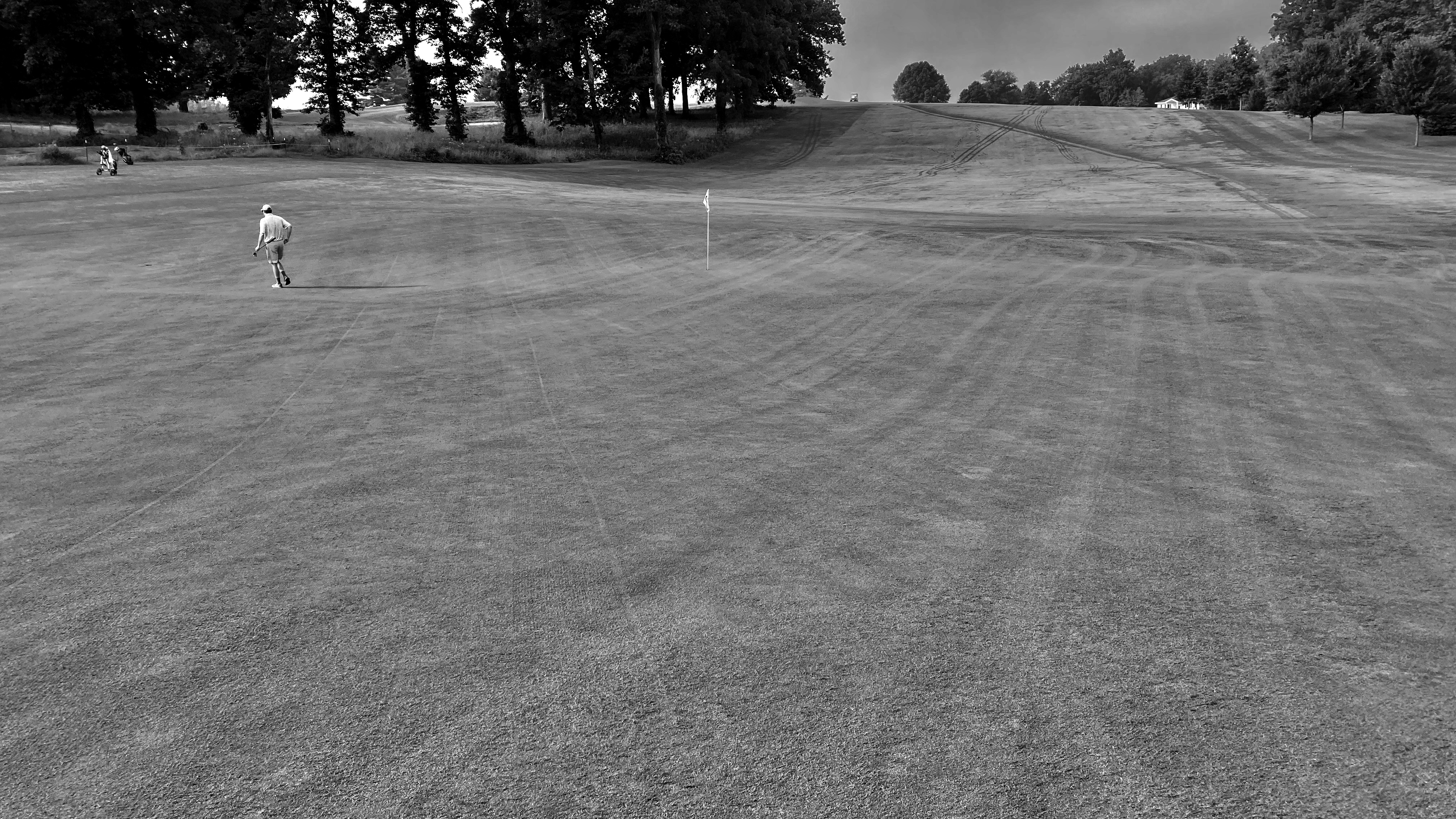 That guy walking around the No. 5 green is weird. More relevant, for scale, is that he’s 6’5″. (Photo Cred: BPBM)
That guy walking around the No. 5 green is weird. More relevant, for scale, is that he’s 6’5″. (Photo Cred: BPBM)
Enter Jim Urbina, the last architect remaining in our pool (as our renovation at Dunes Club undid his awesome green, we brought him in rather than Dick Nugent).
Urbina’s biggest challenge here, or rather my own, is his rather small sample size, at least in terms of certified original work. Most agree he’s deserving of a co-author acknowledgement at Old Macdonald, but outside of that, we’re limited largely to his work as a renovator and restorer at Golden Age clubs. Of those clubs, the two that I most associate with his persistence and long-term involvement are Pasatiempo and Yeamans Hall. The latter has two things going for it: One, I’ve played it, while I haven’t played Pasatiempo. Two, Yeamans comes from Raynor design, which — along with Old Mac — plays into a template theme. So let’s do that.
There are two templates most often associated with par 4.5s — the Road and Raynor’s Prize Dogleg. We’re avoiding Road this year because you already know how the Road hole works, we converted Sheep Ranch No. 17 into one last year, and finally the signature croissant green on a Road differs just too much from the giant slices of sandwich bread that Langford and Moreau present across the rest of this course.
Raynor’s inconsistency with this template also comes in handy for armchair architects. From the few I’ve played-backslash-examined, I gather that it’s a long dogleg, usually with a bunker or two to really make you think about the second shot. Although the Golden Age guy often spread bunkers throughout the fairway, Urbina will play it a bit more conservatively here, using only a pair of paired bunkers, to invoke some hesitation.
First, at about 230 yards out from the back tee, a sizable set of two will be angled so that the former sits safely to the left of the fairway, while the latter creates a clear fulcrum for this dogleg. Considering the uphill nature of the tee shot, the second bunker will blind players to what comes next, and hopefully make folks consider going right, to play the longer, running shot down to the green. The front bunker of this pair may be even more intimidating however, being built into the hillside, with steep walls like those seen elsewhere during the round. The fairway peaks at the far right, so that too will take some distance off the tee ball.
The agreeable nature of No. 5’s green owes much to the leftward slope that continues for most of the hole; those who push right onto this putting surface can count on a punchbowl effect down to where flags are more likely to lie. In other words, right is right for those looking for that easy green-in-two. The second set of Prize Dogleg bunkers comes in here. Just 50 yards from the center of this massive green, they’re a bit nearer to the dance floor than Raynor might have done it, but Raynor didn’t exactly build too many of these with downhill approaches either. Players hitting from position A need to carry roughly 190 from the left to catch that feeder slope. Those from position B are looking at 210, and they likely can’t see the bunkers when they hit.
Those in position A can also attack the green directly along its left side, if they don’t fear the trench bunker running along that side. Urbina will add one of these on the right as well, both to maintain some similarity to the hole’s new Raynorian origins, and to caution players from trusting the punchbowl’s generosity too much. Naturally, those in position B can opt to lay up to the left for a more inviting third shot in.
Which, of course, is how Langford and Moreau always intended players to consider the greens at Culver: Does getting on in two really create the best scoring opportunity?
Thanks for reading, and send feedback via the “Contact” link. Here’s hoping we both get out to some excellent new courses this year to shamelessly critique.
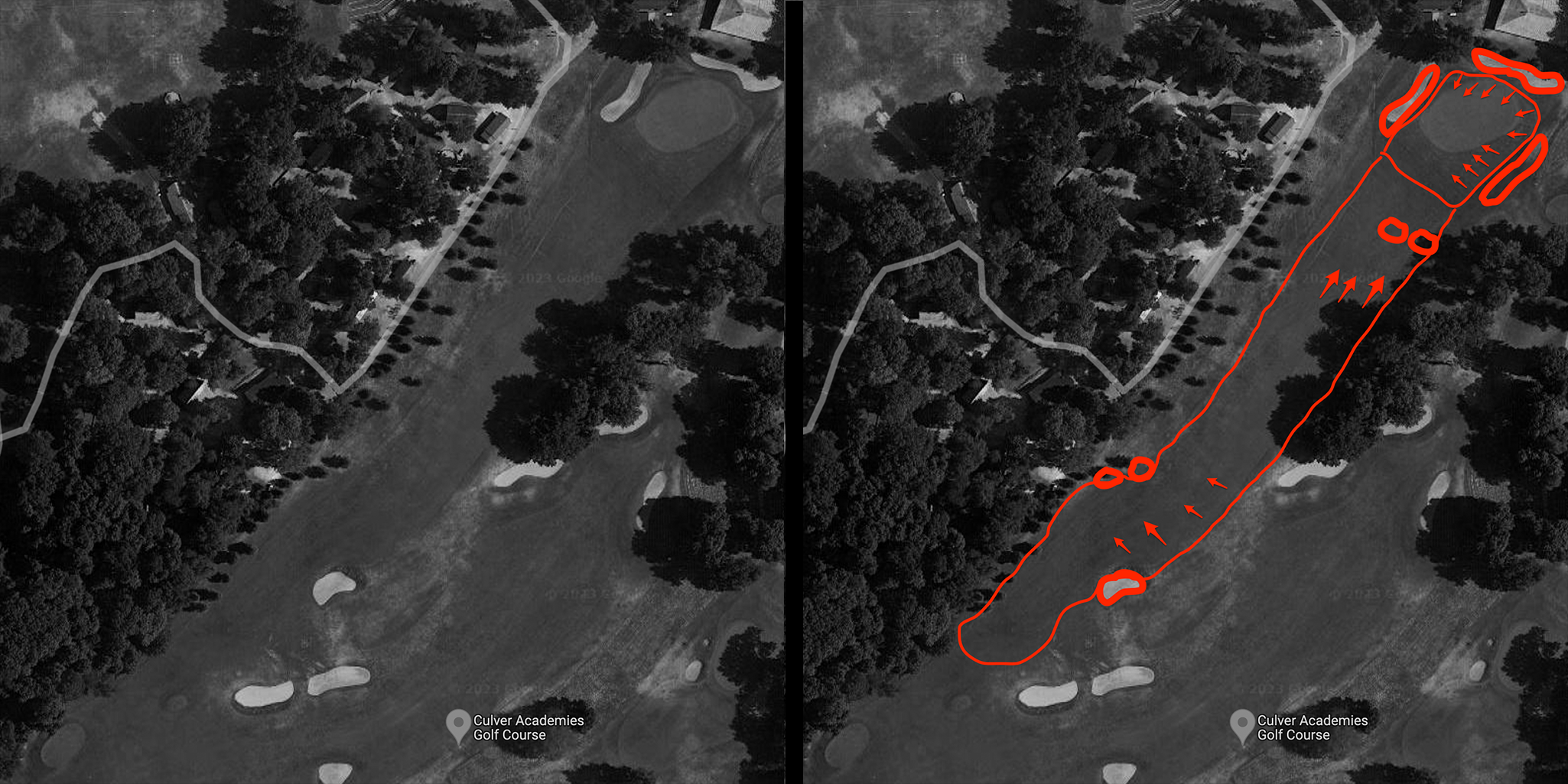 LANGFORD: “You put the fairway bunkers too near to the green.” RAYNOR: “Well don’t make your greens so damn big.” (Photo Cred: BPBM Graphics Team)
LANGFORD: “You put the fairway bunkers too near to the green.” RAYNOR: “Well don’t make your greens so damn big.” (Photo Cred: BPBM Graphics Team)